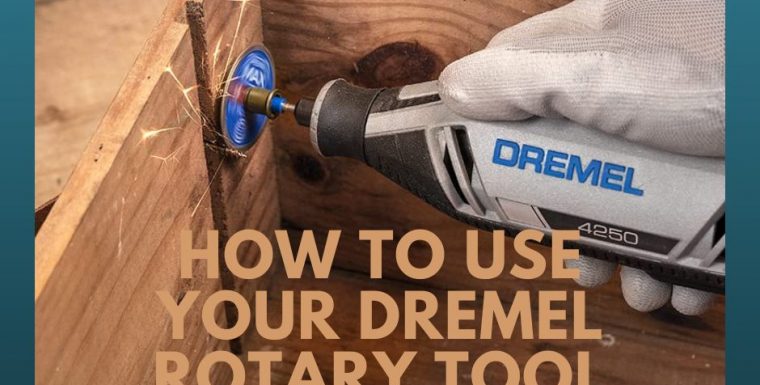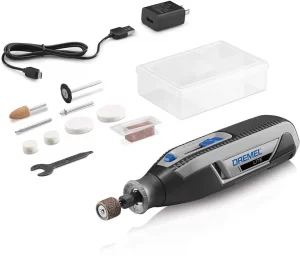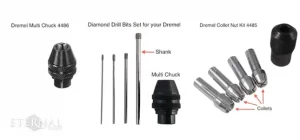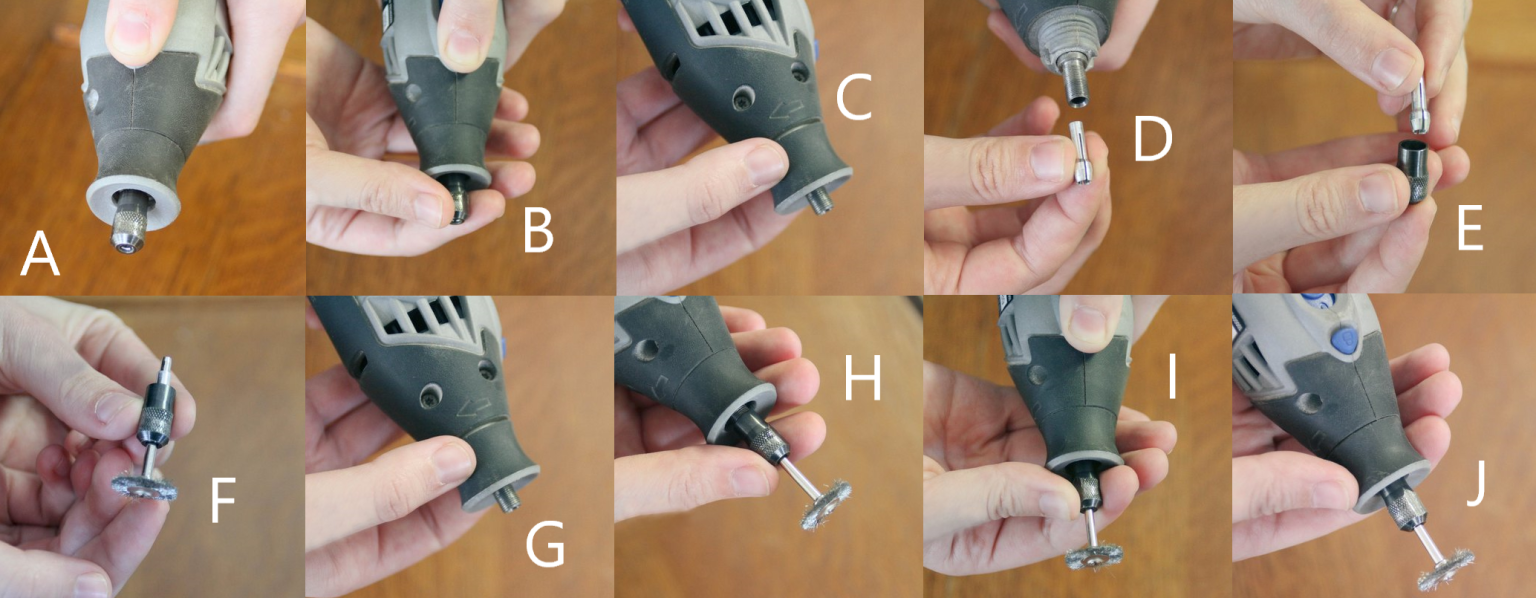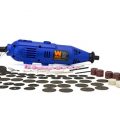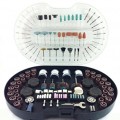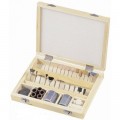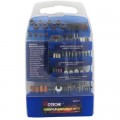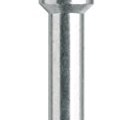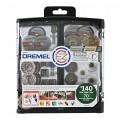The Dremel is a rotary tool which spins at very high rpm’s (rotations per minute). It is a multipurpose tool with many attachments that can easily be changed to suit many different types of jobs.
- Mandrel mounted wheels, sanding drums, cutters or other accessories must be fully inserted into the collet or chuck.
- Position yourself and bystanders away from the plane of the rotating accessory.
- Use face shield, safety goggles or safety glasses.
- Anyone entering the work area must wear personal protective equipment. Fragments of material or of a broken accessory may fly away and cause injury beyond immediate area of operation.
- Never hold a small object in one hand and the tool in the other hand while in use. Clamping a small object allows you to use both of your hand(s) to control the tool.
- Never lay the power tool down until the accessory has come to a complete stop.
- Do not operate the power tool near flammable materials. Sparks could ignite these materials.
Kickback and Related Warnings
- Kickback is a sudden reaction to a pinched or snagged rotating wheel,
backing pad, brush or any other accessory. Kickback is the result of power tool misuse and/or incorrect operating procedures or conditions and can be avoided by taking proper precautions as given below. - Maintain a firm grip on the power tool and position your body and arm to allow you to resist kickback forces.
- Avoid bouncing and snagging the tool.
- Do not attempt to make an excessive depth of cut.
- Do not restart the cutting operation in the workpiece. Let the wheel reach full speed and carefully re-enter the cut.
Wear proper safety gear. Always wear work or rubber gloves when you run the Dremel. Gloves will keep your hands safe from debris and sharp edges. You should also wear safety glasses, especially when cutting, polishing, or grinding with the Dremel.
- Keep your work space clean. You should also keep children and other people away while you’re operating the tool.
Practice inserting and securing bits. To insert a bit, place the bit into the hole at the end of the Dremel and back it out slightly. Tighten the collet nut so that the bit is secure and doesn’t wiggle. To remove the bit, press down on the shaft lock button while turning the collet. This should loosen the bit so you can replace it.
- Make sure to practice inserting and changing the bit when the Dremel is turned off and unplugged.
- Some models are equipped with collets designed for quick and easy connection and release.
- You can also get collets in different sizes for use with different sized accessory shanks.
- In some cases, you will need to use a mandrel, a type of shank with a threaded head. This is a type of permanent shank for use with polishing, cutting, or sanding bits.
Use the right bit for the job. You should choose your bit attachment based on the type of material you’ll be working with. Dremel makes many bits with a variety of materials for almost any material. For example, for:
- Carving and engraving jobs: use high speed cutters, engraving cutters, structured tooth carbide cutters, tungsten carbide cutters and diamond wheel points
- Routing jobs: use router bits (straight, keyhole, corner, or groove). When using a router, take care to only use router bits.
- Small drilling jobs: use drill bits (purchased individually or as a set)
Make sure your Dremel is switched off before you plug it in. Once you plug it in, turn it on to the lowest setting and practice switching to different speeds.
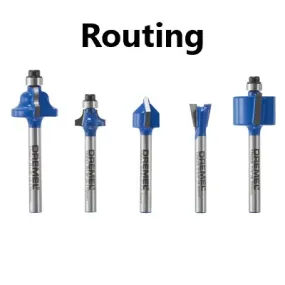 Use your Dremel for small cuts and detailing. The Dremel is lightweight and easy to maneuver, making it deal for small detailing and little cuts. It can be difficult to give smooth, long curves, because you’re mostly working free hand. But, you can make several straight cuts to get the kind of edge you’re looking for and then even up the edge with the sanding bit.
Use your Dremel for small cuts and detailing. The Dremel is lightweight and easy to maneuver, making it deal for small detailing and little cuts. It can be difficult to give smooth, long curves, because you’re mostly working free hand. But, you can make several straight cuts to get the kind of edge you’re looking for and then even up the edge with the sanding bit.
- Avoid using the Dremel for long or large cuts that would be better suited to a larger saw.
Secure the object. Depending on the object or material you’re cutting, secure the object with a vise or clamps. Do not hold the material you’re cutting in your hand if you can help it.
 Cut at the appropriate speed for your bit and the material. A speed that is too high or too low can cause damage to your motor, the bit, or the material you’re working on. If you’re not sure, check your owner’s manual to see what speed is recommended for your particular Dremel and material.
Cut at the appropriate speed for your bit and the material. A speed that is too high or too low can cause damage to your motor, the bit, or the material you’re working on. If you’re not sure, check your owner’s manual to see what speed is recommended for your particular Dremel and material.
- If you’re cutting thicker or tougher material, make several passes to cut it. If the material is too hard and thick to cut without difficulty, you may need to use an oscillating saw rather than a Dremel.
- If you see smoke and discoloration, your speed is too high. If you hear the sound of the motor dropping or slowing down, you may be pressing too hard. Lighten the pressure and readjust the speed.
- Plastic – Fit a flat saw blade onto your Dremel. Remember to put on eye and ear protection before you begin cutting the plastic. Set the speed between 4 and 8 so you have enough power, but don’t burn out the motor. Sand any rough edges once you’ve made the cuts.
- Metal – Secure a metal cutting wheel onto your Dremel. Put on eye and ear protection before you start cutting. Turn on your Dremel and set the power between 8 and 10. Make sure the metal you’re cutting is affixed firmly in place. Gently touch the Dremel to the metal for a few seconds at a time until you see the metal being cut. You’ll also see sparks fly. Fiber reinforced disks are more durable than ceramic disks, which can shatter when cutting metal.
Grind using your Dremel. For grinding, attach grinding stones which can be fixed to the mandrel/shaft. Slide the grinding stone into the front of the tool where it is fully inserted and tighten. Turn your Dremel on and grind on a low setting so you don’t overheat the material. Gently hold the grinding stone against the material until it wears down.
- You can use grinding stones, grinding wheels, chain saw sharpening stones, abrasive wheels and abrasive points to grind a material. Carbide bits tend to work best on metal, porcelain, or ceramic.
- Use cylindrical or triangular tips for round grinds. To grind a notch into something or grind an inside corner, use a flat disc shape. Or, use cylindrical or triangular tips for round grinds.
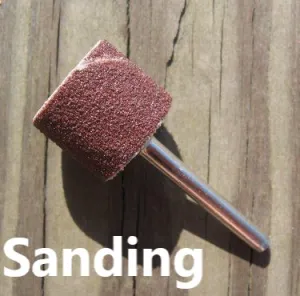 Start sharpening or sanding with your Dremel. Select a sandpaper bit and secure it in your Dremel. Sandpaper bits are available in fine through course grits, and all grades should fit on the same mandrel. Tighten the screw at the end of the sandpaper bit. Turn on your Dremel and set it between 2 and 10. Choose lower settings if you’re sanding or polishing plastics or woods. Select a higher setting if you’re sanding metal. While holding the material secure, run the bit across the material so that the sandpaper bit completely comes into contact with your material and sharpens or sands it.
Start sharpening or sanding with your Dremel. Select a sandpaper bit and secure it in your Dremel. Sandpaper bits are available in fine through course grits, and all grades should fit on the same mandrel. Tighten the screw at the end of the sandpaper bit. Turn on your Dremel and set it between 2 and 10. Choose lower settings if you’re sanding or polishing plastics or woods. Select a higher setting if you’re sanding metal. While holding the material secure, run the bit across the material so that the sandpaper bit completely comes into contact with your material and sharpens or sands it.
- Make sure that the sanding bits are in good shape so they don’t scuff or mark your material. They should fit in the drill snugly and shouldn’t be worn. Have several sanding bits on hand so you can quickly replace them.
- To sand, you can use sanding bands, sanding discs, flap wheels, shaping wheels and finishing and detail abrasive brushes.
Move from coarser bits to softer bits. If you’ve got a big job, begin with coarser bits before moving to softer bits. This can help you sand out larger scratches quickly and then you can have more control over working through the material. If you skip the coarse bit and begin with a softer bit, it will take you longer and you’ll wear out the softer bit.
Polish metal or plastics. The Dremel is an excellent tool for fine-detail polishing or polishing in tight spots. Rub a polishing compound over the surface of your object and fit your Dremel with a felt polishing tip or wheel. Start your drill at a low speed (2) and run it against the polishing compound. You should work the wheel in circles until the material is polished. Avoid using a much higher speed (don’t go over 4).
- You can polish without using a compound, but you’ll get shinier results with it.
- For cleaning and polishing jobs, use rubber polishing points, cloth or felt polishing wheels, and polishing brushes. Be sure to get the right kind of coarse polishing brush for the job. These bits are good for taking old paint off of metal furniture or cleaning up tools and grills.
How to change a Dremel bit
- A: Press and hold the silver-colored Shaft Lock Button near the front edge of the tool.
- B: Unscrew the metal collet nut on the end of the shaft by turning counterclockwise.
- C: Unscrew the plastic housing cap front at the end of the tool by turning counterclockwise.
- D: Remove the collet from the motor shaft. The collet is a small, metal, silver-colored tube wider in the front than the back, which inserts into the motor shaft.
- E: Place the collet inside the metal collet nut.
- F: Insert a Dremel bit through the collet nut and firmly into the collet. The Dremel tool comes with four collet sizes, so use a larger collet to accommodate the shank of larger Dremel bits. The bit should fit snugly inside the collet, with no wiggle or play back and forth.
- G: Thread the plastic housing cap back on the tool but do not tighten.
- H: Insert the collet into the drive shaft with the Dremel bit inside the collet and the collet nut over the assembly.
- I: Tighten the collet nut by hand and press the locking button when the nut is seated to secure the collet and Dremel bit. You will hear a click indicating the drill bit is locked.
- J: Hand tighten the housing nut and pull on the drill bit to ensure it is secure. Your Dremel tool is now ready to use.

